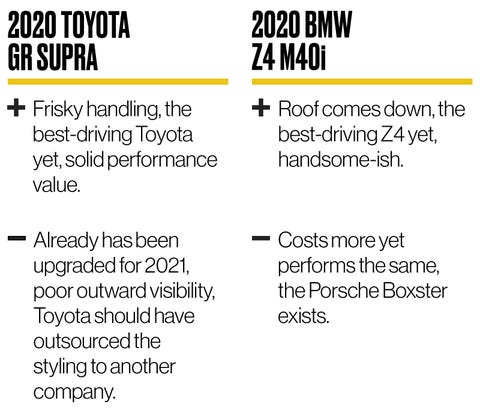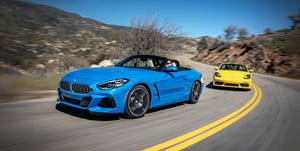Yes, yes, we know. The new Toyota Supra is really a BMW underneath. There’s no need to continue acting shocked about it. Just because someone found a BMW logo on a part under the Supra’s hood does not mean they’ve uncovered a conspiracy. Dan Brown will not be writing a book called The BMW Code.
Both BMW and Toyota have been quite clear about their arrangement: BMW provided most of the mechanical parts for both the latest Z4 and the Supra, and Toyota wrote a large check. Well, one look at the GR Supra reveals that Toyota also styled its own swoopy coupe version of these brothers from different mothers. If, however, you find a Toyota-branded piece under the hood of the Z4, do let us know. We will launch a full investigation. Otherwise, let us see once and for all which of these two near identically performing, near identically sized two-seat sports cars makes better use of the same basic parts. Understand that we wouldn’t ordinarily compare a coupe to a roadster. But then, we wouldn’t ordinarily compare a Toyota to a BMW, either.
The Matchup
For once, finding parity between two comparison-test cars was a snap. Since the 2020 GR Supra can be had only with a (yes, BMW-sourced) turbocharged 3.0-liter inline-six bolted to an eight-speed automatic transmission, we chose that arrangement. For 2021, the Supra will also be offered with the same turbocharged 2.0-liter inline-four that already serves as the BMW Z4’s base engine. Also, for the coming model year, the Supra’s six will get a power boost to 382 horsepower. For now, though, it’s powered by a de-tuned, 335-hp version of that engine.
The choice of BMW for this comparison was easy as well: the Z4 M40i. It’s motivated by an essentially identical turbo 3.0-liter six that makes 382 ponies. Why, you might ask, did the Supra hit the market with the lesser-powered version of this engine only to be upgraded after a year on the market? That would be a good question. Not that it really matters because the performance numbers we gathered at our test facility are right on top of each other. A tenth of a second separates the two cars in the zero-to-60-mph sprint (3.8 seconds for the Z4 and 3.9 for the Supra). The BMW extends its lead slightly through the quarter-mile, posting 12.3 seconds at 116 mph to the Toyota’s 12.5 at 112 mph. At 3375 pounds, the Supra is 160 pounds lighter than the Z4, partially offsetting the Toyota’s power deficit.
The two deliver similar performances around the 300-foot skidpad as well: 1.02 g for the BMW and 1.05 g for the Toyota. Possibly you saw that coming. We did since the two have the same basic suspension arrangements and wear identical Michelin Pilot Super Sports summer tires, sized 255/35R-19 in front and 275/35R-19 in back. Yes, both are “star spec” tires, indicating that they are specific to BMW models. Scandalous! Using the same braking equipment and tires also resulted in nearly identical stops from 70 mph: 148 feet for the BMW and 150 for the Toyota.
One of the few big differences between the two is price. The six-cylinder BMW starts at $64,695. Our test car was equipped with a $500 driver-assistance package that includes park-distance control, blind-spot detection, and lane-departure warning. It also came with a $1400 premium package with remote engine start, head-up display, wireless phone charging, and a Wi-Fi hotspot, and a $2500 executive package with adaptive LED headlights with automatic high-beam functionality, and a upgraded audio system. Matte-finish gray paint added $3600 to the total, which came in at a sizable $73,295.
The Toyota’s price was, of course, lower because Toyota logos cost much less than BMW ones. The 2020 GR Supra 3.0 starts at $50,945. Our test car was of the 3.0 Premium trim level, which adds an 8.8-inch center touchscreen that supports wireless Apple CarPlay connectivity, heated seats, and a premium audio system for an as-tested total of $57,400.
On the Road
For cars that share so much, however, it’s more than just cost and costume that separate them. It’s a good indication of how much of a difference tuning can make. While the BMW feels more like a proper, responsive sports car than any of its predecessors did, it’s the Toyota that’s friskier. Perhaps it has something to do with its cropped coupe top. There’s something serious about a Porsche Cayman compared to an identically equipped Boxster. It’s the same here. But it’s beyond just perception. The Supra’s handling responses make it feel almost nervous, just this side of twitchy. Before you get to know the car and its capabilities, you’re likely to dial back your aggression. But push through those knife-fighter reflexes, and you’re greeted with a highly capable car. Trust the Supra, and it delivers stunning speed.
The Z4 is different. The numbers indicate that it’s just as quick as the Supra, if not more so. But it’s more stoic. There are no feints, no twitches. But neither is there the same playful, just slightly dangerous feel of the Supra. It is, instead, an accomplished roadster that intends to behave in a more reserved manner. The steering, which doesn’t provide a lot of feedback in either car, feels just a bit more distant in the BMW. Although amped up and athletic, the Z4 feels very much like other BMWs. It’s just one of the sportier ones in the lineup. The Supra, in contrast, stands alone from its Toyota brand mates as something distinctly different, something altogether wilder.
The Inside View
Both of these vehicles ride on a short 97.2-inch wheelbase. Both are tight little packages, despite being at least 73 inches wide. In other words, both have similarly impractical natures. While the Supra feels tight and close coupled, the Z4 feels more expansive inside. Indeed, the BMW has infinite headroom, at least with its top down. You might only be able to bring along one other person, but the roofless BMW can play a relaxed grand tourer. The Toyota feels as if it wants you to time your trips to the ice-cream parlor as if they were qualifying laps.
The Toyota’s interior, while naturally full of BMW pieces, is an altogether more serious thing than the Z4’s. That’s certainly true for the specific examples we compared. The Supra’s all-black, low-natural-light cabin is borderline dour. All of the BMW interfaces work well and it’s a pleasant enough place to spend time, but it’s no showboat. Toyota also puts its digital tachometer at the center of the instrument screen, distinct from the BMW setup, which has a styled tachometer and speedometer positioned to the left and right sides of the cluster.
The Z4, on the other hand, is conspicuously outgoing. Even when the top is up, there was so much visual wattage in the Z4 we tested that it seems to generate light from within. The seats are covered in bright-orange leather—okay, it’s called Magma Red, but it’s as orange as the day is long—and lashed with a helter-skelter array of diagonal decorative stitch lines. There’s more orange on the center console and door inserts. Certainly, one could choose not to spec their Z4 quite so flamboyantly, but it will still have a certain fashion-consciousness compared to the harder-core Toyota version.
The Bottom Line
This is perhaps simultaneously the most and the least fair comparison test we’ve done in recent memory. Buyers are unlikely to put both cars on the same shopping list, which is a measure of success for this unlikely alliance. The easy answer is that if you want a roadster, the BMW Z4 is the choice (although you should really also test drive a Porsche Boxster). If you want a racier mien and don’t mind the Supra’s schnoz, that choice is easy, too. Our choice was easier to arrive at than we ever could have imaged. The Supra does everything the BMW can do, but it does it all with a touch more verve, more spirit. That it also costs a whole lot less makes the choice even simpler.
Source: Reviews - aranddriver.com








